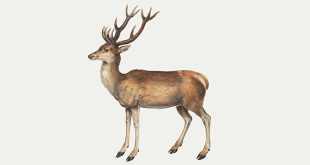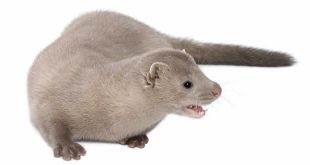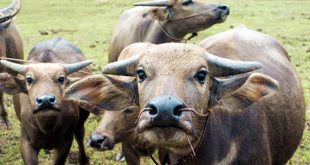 Gerbil — A gerbil is a small mammal of the order Rodentia. Once known simply as “desert rats”, the gerbil subfamily includes about 110 species of African, Indian, and Asian rodents, including sand rats and jirds, all of which are adapted to arid habitats. Most are primarily diurnal (though some, including the common household pet, do exhibit crepuscular behavior), and almost all are omnivorous.
Gerbil — A gerbil is a small mammal of the order Rodentia. Once known simply as “desert rats”, the gerbil subfamily includes about 110 species of African, Indian, and Asian rodents, including sand rats and jirds, all of which are adapted to arid habitats. Most are primarily diurnal (though some, including the common household pet, do exhibit crepuscular behavior), and almost all are omnivorous.
The word “gerbil” is a diminutive form of “jerboa”, though the jerboas are an unrelated group of rodents occupying a similar ecological niche.
One Mongolian species, Meriones unguiculatus, also known as the Clawed Jird, is a gentle and hardy animal that has become a popular pet. It was first brought to the United States in 1954 by Dr. Victor Schwentker for use in research.
Gerbils are typically between six and twelve inches (150 to 300 mm) long, including the tail which makes up approximately one half of their total length. One species however, the Great Gerbil, or Rhombomys opimus, originally native to Turkmenistan, can grow to more than 16 inches (400 mm) in length. The average adult gerbil weighs approximately 2 1/2 ounces. As of August 19, 2003, officials in western China’s Xinjiang Uygur Autonomous Region began releasing eagles to combat the damage they say the great gerbils have done to eleven million acres (46,000 km²) of grassland.
Pet gerbils have an average lifespan of 2 to 4 years. Some have been known to live five or six years.
Gerbils are social animals, and prefer to be kept in groups. Often very large groups work well, as long as the living environment is big enough, otherwise the gerbils may become frustrated and attack one another. Smaller groups of three or four gerbils are most likely to disagree, as they become confused over whether they are dominant or submissive. A male and a female can live together without breeding, although do not rely on this. Female groups are much more quarrelsome than males, but if fighting occurs among males it will be much more vicious. Males will very rarely attack females, and it is possible to introduce complete strangers to one another without previous introduction, which you cannot do with adult gerbils of the same sex. It is also possible to introduce new babies in with adult strangers (even of the same sex), and two groups of babies from different cages will go in together without a problem.
Gerbils favorite foods are seeds and nuts, high in fatty oils. Sunflower seeds, pumpkin seeds and peanuts are favorites of most gerbils, though they have individual preferences. Do not give them too many – you will make them fat, and unhealthy. Gerbils like them so much they will eat huge amount even when they are not hungry, and will even take them from your fingers, often. If a gerbil nips your hand, gently say, “No!” and accompany this sound (in a gerbil’s perspective, a deafening, unsuspected noise) with a gentle puff of air from your mouth to the gerbil’s face. This can also be used with any other behavior problems you encounter with you gerbil. Just be sure not to over do it, as the gerbil will becom extremely annoyed. You can hand-train your gerbils by removing all seeds and nuts from a store-bought food. Store these treats in another container, and only let a gerbil have one when he/she takes it from your hand.
They also enjoy fruit peel such as orange and banana. In fact, gerbils will eat almost anything; dog biscuits and chews; rat food; rabbit food; guinea pig food; oats; various “special” treats from pet shops, which in fact were not appreciated nearly as much as some parsnip cores. Most weeds dubbed as safe for grazing animals like rabbits or guinea pigs are fine for gerbils, although if unsure do not take the risk. They also love veggies. Do not leave fresh fruit or vegetables unattended for more than six hours, as they may spoil or rot and cause respitory infections or other illnesses and diseases.
Gerbils love to jump, climb, chew, and dig. There may be a danger to a gerbil jumping and hitting his/her head on the roof, as he/she might break the neck, back, skull when connecting with the roof, or when they land ungracfully. The digging motions are very common: the gerbil screws its face up and move its arms so rapidly they are a blur, making a light scratching noise on the side of their cage. Gerbils cannot do this in a barred cage, but use their powerful back feet to dig holes and tunnels in the bedding. Gerbils are not unhappy in their living environment when they dig – they are merely acting on instinct. Even if you get them out to play, the moment you put them back in they’ll start digging. If a gerbil looks as though he/she is frantically trying to escape by tunnelling out the corner, do not be alarmed. They are not trying to escape (and they couldn’t if they tried that way), but it its simply responding to what its insticts are telling it: if you cant walk around, over, or under something, tunnel through it!
Gerbils often stand at a high place and keep lookout. If you make a noise, they will often stand up straighter to investigate. Every so often the “lookout” switches. Sometimes gerbils zone out while chewing on the bars, giving them a dazed, half asleep look. Often they will stop moving and just sit there with their teeth clamped firmly over the bars. Do not be concerned, that is perfectly normal behaviour. They are still sensitive to noises and shadows, as the wild gerbils are prey for birds and snakes.
 Kids Portal For Parents India Kids Network
Kids Portal For Parents India Kids Network






